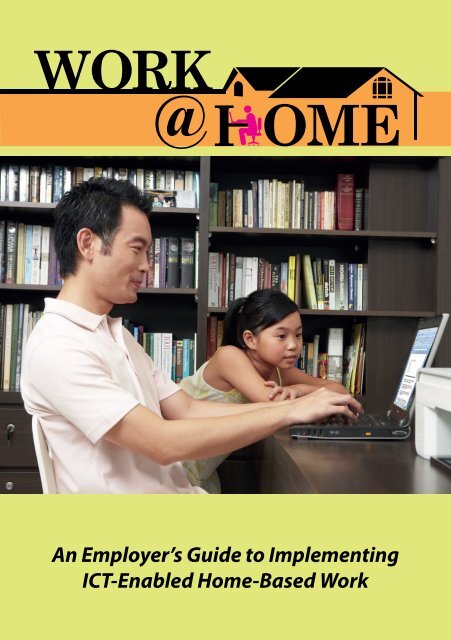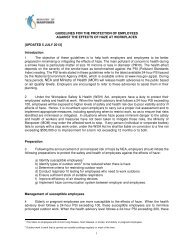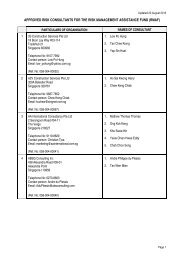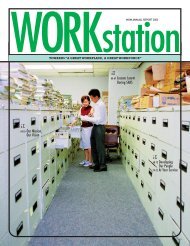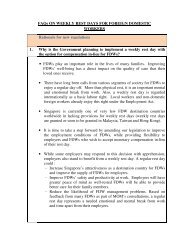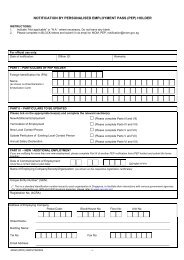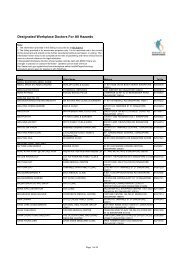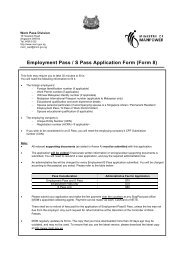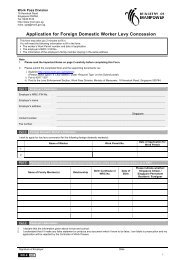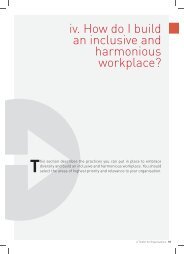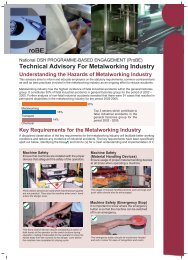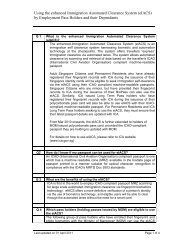An Employer's Guide to Implementing ICT-Enabled Home-Based Work
An Employer's Guide to Implementing ICT-Enabled Home-Based Work
An Employer's Guide to Implementing ICT-Enabled Home-Based Work
Create successful ePaper yourself
Turn your PDF publications into a flip-book with our unique Google optimized e-Paper software.
WORK<br />
@<br />
OME<br />
<strong>An</strong> Employer’s <strong>Guide</strong> <strong>to</strong> <strong>Implementing</strong><br />
<strong>ICT</strong>-<strong>Enabled</strong> <strong>Home</strong>-<strong>Based</strong> <strong>Work</strong>
The Tripartite Committee on <strong>Work</strong>-Life Strategy thanks the<br />
following for their support in the development of this guide:<br />
American Express<br />
IBM Singapore<br />
SP Services Ltd.<br />
Tripartite <strong>Work</strong>group on <strong>ICT</strong>-<strong>Enabled</strong> <strong>Home</strong>-<strong>Based</strong> Jobs
TABLE OF CONTENT<br />
INTrOduCTION TO HOmE-BAsEd WOrk<br />
THE CAsE FOr HOmE-BAsEd WOrk<br />
ImpLEmENTINg HOmE-BAsEd WOrk<br />
CHECkLIsT FOr ImpLEmENTINg<br />
HOmE-BAsEd WOrk ArrANgEmENTs<br />
FACILITATINg COmmuNICATION<br />
ANd COLLABOrATION WITH<br />
HOmE-BAsEd EmpLOyEEs<br />
pErFOrmANCE mANAgEmENT FOr<br />
HOmE-BAsEd EmpLOyEEs<br />
OrgANIsATIONAL CHANgE sTrATEgy<br />
guIdE FOr THE HOmE-BAsEd EmpLOyEE<br />
CAsE sTudIEs<br />
rEsOurCEs<br />
TABLE OF CONTENT<br />
WORK @<br />
OME<br />
1<br />
2<br />
3<br />
4<br />
7<br />
9<br />
11<br />
13<br />
17<br />
25
1<br />
INTrOduCTION TO HOmE-BAsEd WOrk<br />
WORK @<br />
OME<br />
INTrOduCTION TO<br />
HOmE-BAsEd WOrk<br />
What is <strong>Home</strong>-<strong>Based</strong> <strong>Work</strong>?<br />
<strong>Home</strong>-based work is an alternative form of work arrangement that involves an<br />
employee working primarily from home, rather than in a conventional office<br />
setting. Infocomm Technology (<strong>ICT</strong>) plays an important role by providing the<br />
infrastructure and <strong>to</strong>ols that connect home-based workers <strong>to</strong> their offices and<br />
clients. This innovative way of working has been adopted by savvy businesses<br />
which recognise the cost savings and improved productivity amongst a myriad of<br />
other benefits <strong>to</strong> be gained.<br />
<strong>An</strong> Employer’s solution <strong>to</strong> the manpower-Crunch<br />
<strong>Home</strong>-based work can also offer a much-needed solution for businesses<br />
facing a manpower-crunch. Organisations can tap in<strong>to</strong> a rich resource pool of<br />
economically inactive residents, some of whom may not be able <strong>to</strong> leave home<br />
for office-based work for various reasons, such as family care responsibilities.<br />
<strong>Home</strong>-based work will allow them <strong>to</strong> pursue a career while meeting their personal<br />
commitments. This work arrangement is also an ideal option <strong>to</strong> retain valuable<br />
and experienced employees who are considering leaving the organisation due <strong>to</strong><br />
similar commitments.<br />
The role of <strong>ICT</strong> in <strong>Home</strong>-<strong>Based</strong> <strong>Work</strong><br />
<strong>ICT</strong> offers the infrastructure and <strong>to</strong>ols <strong>to</strong> make home-based work a reality in<br />
<strong>to</strong>day’s tech-reliant work environment. <strong>ICT</strong> enables home-based employees <strong>to</strong><br />
efficiently complete work tasks and also effectively communicate with colleagues<br />
and clients. Currently, local residents own at least one computer within the home,<br />
and with the progressive roll-out of the Next Generation Nationwide Broadband<br />
Network (Next Gen NBN), the majority of Singapore homes will have access <strong>to</strong><br />
ultra-high speed broadband connection by mid-2012. Against this backdrop, homebased<br />
work is fast becoming a viable option in Singapore and offers employers a<br />
competitive edge in attracting quality talent.
THE CAsE FOr HOmE-BAsEd<br />
WOrk<br />
For Employers<br />
THE CAsE FOr HOmE-BAsEd WOrk<br />
WORK @ OME<br />
<strong>Home</strong>-based work helps <strong>to</strong> enhance business performance and competitiveness for<br />
employers in several ways.<br />
1.<br />
Enhance Talent Attraction & retention<br />
Employers have the advantage of choosing from a wider pool of talent, including<br />
skilled and experienced job seekers who require flexible work arrangements for<br />
reasons such as family care responsibilities.<br />
It also helps <strong>to</strong> retain experienced and valued employees within the organisation<br />
who are unable <strong>to</strong> continue with regular office-based work because of changes<br />
in personal circumstances.<br />
2. reduce Cost<br />
<strong>Home</strong>-based work helps employers <strong>to</strong> reduce staff turnover-related costs and<br />
other fixed costs such as office rental and workstations set-up cost<br />
3.<br />
4.<br />
Improve productivity<br />
Employers have greater flexibility <strong>to</strong> roster home-based employees according<br />
<strong>to</strong> demands of the business. This helps <strong>to</strong> optimise manpower and resources<br />
deployment resulting in higher productivity for the organisation.<br />
Improve Cus<strong>to</strong>mer service<br />
Flexibility of work hours in home-based work enhances cus<strong>to</strong>mer service as<br />
business hours can be extended and timely assistance offered.<br />
5. Enhance Business Continuity<br />
Employers with home-based employees are less likely <strong>to</strong> be affected by<br />
incidents that could prevent employees from going <strong>to</strong> the office <strong>to</strong> work such<br />
as flu pandemic outbreaks.<br />
For Employees<br />
1. Facilitate participation in the <strong>Work</strong>place<br />
<strong>Home</strong>-based work provides job seekers and employees who are not able <strong>to</strong><br />
perform regular office-based work the opportunity <strong>to</strong> join in the workforce and<br />
contribute <strong>to</strong> the organisation and economy in a meaningful way. It also enables<br />
them <strong>to</strong> earn a regular salary <strong>to</strong> supplement household income.<br />
2. Enhance <strong>Work</strong>-Life Harmony<br />
There is greater flexibility in work arrangements and hours, enabling employees<br />
<strong>to</strong> achieve a better balance between career and personal life.<br />
2
3<br />
ImpLEmENTINg HOmE-BAsEd WOrk<br />
WORK @ OME<br />
ImpLEmENTINg HOmE-BAsEd<br />
WOrk<br />
According <strong>to</strong> a survey by the Ministry of Manpower 1 , there were more than<br />
270,000 economically inactive residents in the prime working age of 25 <strong>to</strong> 54 in<br />
2010. Women made up the majority (85%) of this group and the main reason cited<br />
for exiting the workforce was family responsibilities. With the right support and<br />
flexible work arrangement, this large pool of untapped manpower resources can<br />
be gainfully employed and fulfill their personal commitments at the same time.<br />
This section is designed <strong>to</strong> equip employers with the necessary framework for<br />
incorporating home-based work within their employment schemes.<br />
1 Report on Labour Force in Singapore 2010
1. get Buy-In from senior management<br />
CHECkLIsT FOr ImpLEmENTINg HOmE-BAsEd<br />
WOrkINg ArrANgEmENTs<br />
WORK @ OME<br />
CHECkLIsT FOr ImpLEmENTINg<br />
HOmE-BAsEd WOrkINg<br />
ArrANgEmENTs<br />
• Get buy-in and support from <strong>to</strong>p management prior <strong>to</strong> embarking on the<br />
initiative.<br />
• Highlight successful cases of home-based work in other organisations,<br />
both local and international.<br />
• Make available tips on implementing home-based work <strong>to</strong> build<br />
confidence amongst senior management, that it can be done and dispel<br />
any negative preconceptions about home-based work.<br />
2. Assess suitability of Jobs for a <strong>Home</strong>-<strong>Based</strong> Environment<br />
• <strong>Home</strong>-based work generally requires <strong>ICT</strong> and/or specific job-related skills<br />
and knowledge.<br />
• Evaluate existing jobs <strong>to</strong> see if they can be performed at home. Some<br />
helpful questions <strong>to</strong> ask:<br />
o Does the job require direct supervision?<br />
o Does the job require face-<strong>to</strong>-face interaction with colleagues/clients?<br />
o What is the impact on other employees?<br />
o What is the equipment required and can it be set up at home?<br />
o Would confidential information be compromised?<br />
3. pilot <strong>Home</strong>-<strong>Based</strong> Jobs<br />
• Start with pilot projects <strong>to</strong> assess the suitability of the work <strong>to</strong> be homebased.<br />
• Pilots provide an opportunity <strong>to</strong> uncover issues and resolve problems<br />
within a smaller and more controllable environment before expanding the<br />
scale of home-based work for the organisation.<br />
4. Create/re-design Existing Organisational systems<br />
• Review infrastructure, work processes and management systems. Assess<br />
the need <strong>to</strong> refine or even redesign them <strong>to</strong> integrate home-based work<br />
within the organisation.<br />
4
CHECkLIsT FOr ImpLEmENTINg HOmE-BAsEd<br />
WOrk ArrANgEmENTs<br />
5 WORK OME<br />
@<br />
• Review and/or re-design human resource systems (performance<br />
management and appraisal practices) <strong>to</strong> take in<strong>to</strong> account home-based<br />
work. This will ensure that employees who work from home are appraised<br />
fairly on measurable deliverables rather than on the amount of time spent<br />
in the office.<br />
• Equip managers with the necessary skills and knowledge <strong>to</strong> manage and<br />
moni<strong>to</strong>r home-based employees.<br />
5. Establish policy and pro<strong>to</strong>col for <strong>Home</strong>-<strong>Based</strong> <strong>Work</strong><br />
• Written Agreement<br />
o Formalise job description and terms of employment between<br />
organisation and the employee.<br />
o Clearly state deliverables and performance indica<strong>to</strong>rs on which<br />
employee performance will be assessed.<br />
• Accountability<br />
o Set clear line of reporting and formally establish a direct supervisor for<br />
each employee working from home.<br />
o Au<strong>to</strong>mate management <strong>to</strong>ols <strong>to</strong> enable supervisors <strong>to</strong> remotely<br />
moni<strong>to</strong>r the performance and progress of employees.<br />
• Security Issues<br />
o Ensure appropriate forms of protection such as password, finger-print/<br />
voice recognition for access <strong>to</strong> the corporate network and data.<br />
o Set clear and proper guidelines on use of official data especially for<br />
information that is private and confidential.<br />
o Make sure home-based employees’ home computer/lap<strong>to</strong>p is properly<br />
configured, adequate firewall and virus protection installed, <strong>to</strong> prevent<br />
security breaches.<br />
• Communication<br />
o Schedule regular communication sessions for home-based employees <strong>to</strong><br />
receive sufficient guidance and men<strong>to</strong>ring in their work.<br />
o Include home-based employees in regular internal communications<br />
<strong>to</strong> foster a sense of belonging <strong>to</strong> the company and ensure they are kept<br />
updated on happenings within the organisation.
6. Empower <strong>Home</strong>-<strong>Based</strong> Employees<br />
WORK @ OME<br />
• Digitise key workflow processes <strong>to</strong> facilitate easy access <strong>to</strong> corporate<br />
resources.<br />
• Provide training <strong>to</strong> equip employees with the necessary skills and<br />
knowledge <strong>to</strong> work effectively from home. This may include training in the<br />
use of basic IT software and creating a Standard Operating Procedure<br />
(SOP) for communications and use of social networking <strong>to</strong>ols.<br />
• Subsidise the cost of equipment such as lap<strong>to</strong>ps, broadband service,<br />
thin-clients etc.<br />
7. review processes and systems regularly<br />
CHECkLIsT FOr ImpLEmENTINg HOmE-BAsEd<br />
WOrk ArrANgEmENTs<br />
• Evaluate work processes and systems on a regular basis and fine-tune<br />
them according <strong>to</strong> the changing needs of the organisation and employees.<br />
• Get feedback and suggestions from home-based employees as well as<br />
their direct supervisors <strong>to</strong> moni<strong>to</strong>r and evaluate effectiveness of<br />
home-based work.<br />
6
7<br />
FACILITATINg COmmuNICATION ANd COLLABOrATION<br />
WITH HOmE-BAsEd EmpLOyEEs<br />
WORK @ OME<br />
FACILITATINg COmmuNICATION<br />
ANd COLLABOrATION WITH<br />
HOmE-BAsEd EmpLOyEEs<br />
Effective communication is vital for a successful<br />
home-based working arrangement. These are<br />
some methods <strong>to</strong> connect your employees:<br />
a Connect employers and employees via<br />
high speed broadband and<br />
communication <strong>to</strong>ols.<br />
a Establish mechanisms for maintaining<br />
regular contact.<br />
a Schedule periodic face-<strong>to</strong>-face meetings<br />
<strong>to</strong> help remote employees stay connected<br />
as well as facilitate interaction and team<br />
building.<br />
a Put home-based employees in teams with<br />
full-time personnel so as <strong>to</strong> facilitate<br />
better team work amongst them.
FACILITATINg COmmuNICATION ANd COLLABOrATION<br />
WITH HOmE-BAsEd EmpLOyEEs<br />
WORK @ OME<br />
8
9<br />
pErFOrmANCE mANAgEmENT FOr<br />
HOmE-BAsEd EmpLOyEEs<br />
WORK @ OME<br />
pErFOrmANCE mANAgEmENT FOr<br />
HOmE-BAsEd EmpLOyEEs<br />
o Set Key Performance Indica<strong>to</strong>rs (KPIs)<br />
a Appropriate and realistic KPIs should be set for home-based employees.<br />
These should be Specific, Measurable, Actionable, Realistic, and Time-<br />
Specific (SMART).<br />
o Positive Reinforcement<br />
a As home-based employees have less face-<strong>to</strong>-face interaction with their<br />
supervisors, it is especially important that supervisors prioritise giving<br />
them feedback on tasks and projects.<br />
a Motivate by reward rather than through penalty/fear.<br />
o Establish Clear Expectations<br />
a Set clear expectations of the job scope and responsibilities <strong>to</strong> avoid<br />
misunderstandings and miscommunication.<br />
a Draw up a written agreement stipulating the working conditions (e.g.<br />
specific working hours, availability for face-<strong>to</strong>-face meetings etc) and<br />
KPIs <strong>to</strong> be met and get the supervisor and employee <strong>to</strong> sign-off on the<br />
document.<br />
o Manage the Time Difference<br />
a This applies <strong>to</strong> those who have offices/operations in<br />
other countries or in different time zones.
pErFOrmANCE mANAgEmENT FOr<br />
HOmE-BAsEd EmpLOyEEs<br />
WORK @ OME<br />
10
11<br />
OrgANIsATIONAL CHANgE sTrATEgy<br />
WORK @ OME<br />
OrgANIsATIONAL CHANgE sTrATEgy
getting support and Buy-In of Employees<br />
OrgANIsATIONAL CHANgE sTrATEgy<br />
WORK @ OME<br />
While home-based work is currently available in Singapore, these make up merely<br />
a small proportion of all jobs created. Take-up rate by employees is low, perhaps<br />
due <strong>to</strong> a lack of awareness of the availability of home-based work. Employees may<br />
also have the notion that taking on home-based work would affect their career<br />
prospects.<br />
Employers can take these critical steps <strong>to</strong> educating employees on the viability of<br />
home-based work:<br />
• Communicate success s<strong>to</strong>ries <strong>to</strong> show how the home-based work<br />
arrangement has benefited both the organisation and employees.<br />
• Equip employees with the necessary skills and knowledge <strong>to</strong> work<br />
independently from home.<br />
developing an Organisational Change strategy<br />
This is a vital step in ensuring sustainable change and a smooth transition <strong>to</strong> a<br />
new way of working for all involved. A successful strategy should:<br />
a Build a supportive workplace culture where home-based work becomes an<br />
acceptable “ethos” and not frowned upon.<br />
a Communicate a clear direction and decisive plan of action.<br />
a Engage all employees prior <strong>to</strong> implementation - providing feedback<br />
channels and addressing all queries and concerns in a transparent manner.<br />
a Show commitment of senior management and leadership <strong>to</strong> the new<br />
work arrangement.<br />
a Be flexible <strong>to</strong> tweak policies and processes over time <strong>to</strong> meet the changing<br />
needs of the market and employees.<br />
Ultimately, implementing home-based work is a joint effort between employer and<br />
employees. When everyone shares the same vision and goal for organisational<br />
success, then a home-based work arrangement can be effectively integrated in<strong>to</strong><br />
the corporate culture.<br />
12
13<br />
guIdE FOr HOmE-BAsEd EmpLOyEE<br />
WORK @ OME<br />
guIdE FOr THE HOmE-BAsEd<br />
EmpLOyEE<br />
Some may think that being a home-based employee means you can afford <strong>to</strong><br />
be unstructured and less organised. The reverse is true. Whereas an officebased<br />
employee can rely on the processes and infrastructure provided by the<br />
organisation, a home-based employee needs <strong>to</strong> be disciplined and organised,<br />
implement processes and effectively ‘self-manage’ their work in order <strong>to</strong> be<br />
productive and meet KPIs.<br />
A. Traits of a successful <strong>Home</strong>-<strong>Based</strong> Employee<br />
o Understand the Motivation for <strong>Work</strong>ing<br />
a <strong>An</strong>swer the question of “why are you working?” Understanding the<br />
reasons and motivation for working is important as it helps the homebased<br />
employee <strong>to</strong> manage and master the roles and responsibilities<br />
they are given.<br />
a The reasons <strong>to</strong> work may evolve over time as one moves through<br />
different life stages and personal circumstances change. This can be a<br />
fac<strong>to</strong>r in deciding the type of work and number of hours worked. For<br />
instance, a mother with pre-school children will have different reasons<br />
for working from home, compared <strong>to</strong> one with adult children.<br />
o Develop a Plan<br />
a Planning allows one <strong>to</strong> identify and focus on “major” issues and tasks,<br />
which are critical for work success.<br />
a Be intentional and strategic when working instead of waiting for things<br />
<strong>to</strong> happen.<br />
a Have a concrete plan and execute it.<br />
a Put the plan on paper and pin it up at the workstation as a constant<br />
reminder.
o Set Objectives<br />
guIdE FOr HOmE-BAsEd EmpLOyEE<br />
WORK @ OME<br />
a Set SMART goals. S – Specific, M – Measurable, A – Achievable, R –<br />
Realistic, T – Time-Specific<br />
a Review outcomes against objectives regularly (once a month/quarterly/<br />
half-yearly).<br />
o Be Flexible<br />
a Be willing <strong>to</strong> fine-tune or change methods that do not yield the<br />
desired results.<br />
a Be flexible without compromising on quality of work and deliverables.<br />
B. Tips on setting up <strong>Home</strong>-<strong>Based</strong> <strong>Work</strong>space<br />
o Create a Physical <strong>Work</strong>space<br />
a This helps <strong>to</strong> mentally separate work from household responsibilities<br />
and set the appropriate frame of mind for work. Ensure that the chosen<br />
workspace has minimal distractions so that work-related tasks can be<br />
efficiently attended <strong>to</strong>, e.g. taking client phone calls, attending <strong>to</strong><br />
emails, etc.<br />
a The home-office should be equipped with the necessary items <strong>to</strong><br />
perform work, e.g. work table, chair, stationery, dictionary, calcula<strong>to</strong>r,<br />
paper, files, folders, etc.<br />
o Set Boundaries<br />
a Decide on the working hours at home and stick <strong>to</strong> it unless there is an<br />
emergency.<br />
a Make arrangements for other responsibilities such as child-care or<br />
elder-care beforehand.<br />
a Establish an understanding with family members on the blocks of time<br />
when you will be working and hence are not <strong>to</strong> be disturbed.<br />
a Do not be distracted by unnecessary or unimportant tasks during<br />
working hours.<br />
14
15<br />
guIdE FOr HOmE-BAsEd EmpLOyEE<br />
WORK @ OME<br />
C. managing relationships and Communication<br />
o Establish Accountability<br />
a Be clear on who the direct line of report is.<br />
a Do not be afraid <strong>to</strong> ask for help when the need arises.<br />
a Seek constructive feedback from superior and colleagues within the<br />
same team.<br />
o Build Good <strong>Work</strong>ing Relationships<br />
a Make time and effort <strong>to</strong> interact with colleagues in the office on a<br />
regular basis.<br />
a Schedule time for regular face-<strong>to</strong>-face meetings with supervisor and<br />
colleagues.<br />
o Prioritise Communication<br />
a Keep updated on news and<br />
developments of the organisation<br />
via office email, newsletter,<br />
website, social media channels,<br />
etc.<br />
a Identify time slots when you can<br />
take calls or reply <strong>to</strong> emails/<br />
messages.
guIdE FOr HOmE-BAsEd EmpLOyEE<br />
WORK @<br />
OME<br />
16
17<br />
CAsE sTudy #1 - AmErICAN EXprEss<br />
WORK @<br />
OME<br />
CAsE sTudy #1 – AmErICAN<br />
ExprEss<br />
About the Company<br />
American Express is a global service company, providing cus<strong>to</strong>mers with access<br />
<strong>to</strong> products, insights and experiences that enrich lives and build business success.<br />
It is also the largest card issuer by purchase volume and operates a worldwide<br />
network that processes millions of merchant transactions daily.<br />
American Express offers a broad array of payment, expense management and<br />
travel solutions for consumers, small businesses, mid-sized companies and large<br />
corporations.<br />
American Express has more than 60,000 employees worldwide with operations<br />
in more than 130 countries.<br />
<strong>Home</strong>-based <strong>Work</strong><br />
American Express has offered its employees Flexible <strong>Work</strong> Arrangements<br />
(FWAs) since 2005 in a bid <strong>to</strong> help employees achieve work-life harmony. The<br />
organisation’s HR policies extend benefits beyond the statu<strong>to</strong>ry requirements <strong>to</strong><br />
support employees as they juggle work and personal life.
More than 25% of American Express’ employees currently utilise some form of FWA.<br />
Notably, more than half of the organisation’s employees are women, many of whom<br />
are married. FWAs have proved <strong>to</strong> be popular with this demographic and most female<br />
employees have taken up these benefits, at various points in their career.<br />
Nature of <strong>Work</strong><br />
FWAs range from staggered working hours <strong>to</strong> remote, off-site work areas. Within<br />
the FWAs, additional flexibility may be considered on a case-by-case basis. The<br />
organisation offers flexible work styles called ‘Blue <strong>Work</strong>styles’. These are:<br />
o Hub - dedicated office workplace.<br />
o Club - mobile office & shared workspace with company provision for home<br />
office setup when working from home more than two days.<br />
o <strong>Home</strong> - dedicated home office with company provision for home office setup.<br />
o Roam - mobile and drop-in hub where employee primarily works at client<br />
locations with regular short visits <strong>to</strong> office.<br />
<strong>ICT</strong> support structures<br />
• Virtual Private Network (VPN)<br />
• Avaya Communica<strong>to</strong>rs<br />
• Broadband internet access<br />
• IT software (eg. computer programmes)<br />
• IT hardware (eg. lap<strong>to</strong>ps)<br />
Benefits<br />
A. Employer<br />
o American Express is viewed as an Employer of Choice, increasing its chances<br />
in attracting and retaining high caliber talent.<br />
o The organisation experiences higher productivity, as employees are happier<br />
and more motivated at work.<br />
o Increase in employee retention and engagement which translates <strong>to</strong> lower<br />
HR costs in the areas of recruitment and training new employees.<br />
B. Employees<br />
CAsE sTudy #1 - AmErICAN EXprEss<br />
WORK @ OME<br />
o Increased personal satisfaction as employees are given the opportunity <strong>to</strong><br />
grow professionally without compromising their personal goals.<br />
18
CAsE sTudy #1 - AmErICAN EXprEss<br />
19 WORK OME<br />
@<br />
o Feel a strong sense of being valued and well looked after.<br />
“In my role I am in contact with markets across all time zones around the<br />
world, which means working on emails and talking <strong>to</strong> my colleagues or our<br />
partners not just during my office hours but theirs as well. While I certainly<br />
performed all these duties well going <strong>to</strong> an assigned desk in the office daily,<br />
working from home now is a friendlier arrangement, especially for days when<br />
I start early and end very late. <strong>Work</strong>ing from home also means I save time<br />
when dropping off or picking up my infant daughter at her full-day infant<br />
care centre near my home, and I can also reach her faster during the day<br />
should the need arise.”<br />
Jessica Goh, Manager, International Communications Team<br />
kEy CHALLENgEs sOLuTIONs<br />
1. Fewer opportunities <strong>to</strong> interact<br />
socially with colleagues and<br />
superiors.<br />
2. Moni<strong>to</strong>ring progress and<br />
performance of employees when<br />
they are not in the office.<br />
o Provides tele-conferencing<br />
<strong>to</strong> facilitate communication and<br />
interaction especially for employees<br />
in remote locations.<br />
o Provides opportunities for<br />
networking, such as:<br />
• Family Day where employees’<br />
families can visit the workplace.<br />
• ‘Healthy Living’ where employees<br />
and their family members had a<br />
day out at Sen<strong>to</strong>sa.<br />
• The ‘Women’s Interest Network’<br />
(WIN) which is an employee<br />
voluntary group with an interest<br />
in women’s career development<br />
and work life balance.<br />
o Promote a culture of open<br />
communication between leaders<br />
and employees. Leaders have<br />
regular one-on-one sessions with<br />
employees <strong>to</strong> check on their<br />
progress, discuss issues and receive<br />
feedback.
CAsE sTudy #2 – IBm<br />
About the Company<br />
WORK @ OME<br />
IBM creates business value for clients and solves business problems through<br />
integrated solutions that leverage information technology and deep knowledge<br />
of business processes. IBM solutions typically create value by reducing a client’s<br />
operational costs or by enabling new capabilities that generate revenue.<br />
Today IBM employees from about 37 nationalities work in Singapore, where IBM’s<br />
ASEAN headquarters is located. The IBM Singapore office also has members from<br />
regional and global IBM teams. IBM has over 426,600 employees globally in more<br />
than 170 countries, spanning various countries and time-zones.<br />
<strong>Home</strong>-<strong>Based</strong> <strong>Work</strong><br />
In the late 1990s, IBM introduced innovative flexible work options such as its<br />
“Mobility Program” that gives employees the flexibility <strong>to</strong> decide when and where<br />
work gets done. As all IBM employees are telecommuting-enabled, they have access<br />
<strong>to</strong> mobility <strong>to</strong>ols and processes that allow them <strong>to</strong> work at a location convenient <strong>to</strong><br />
them at any time, as long as their business goals are met by the required time.<br />
Worldwide, about 60% of IBM employees are on its “Mobility Program” and they are<br />
empowered <strong>to</strong> work from any location such as satellite offices, clients’ offices or at<br />
home. In IBM Singapore, 5% of the employees work from home.<br />
Nature of <strong>Work</strong><br />
With the sophistication of <strong>ICT</strong> in the business environment, there is a growing<br />
realisation that the standard work model has <strong>to</strong> evolve with the times – one that<br />
requires a far more flexible work arrangement than the traditional office, coupled<br />
with the need <strong>to</strong> respond <strong>to</strong> the changing needs of its employees working in a fastpaced,<br />
borderless setting as well as <strong>to</strong> serve global clients more effectively.<br />
<strong>ICT</strong> support structures<br />
In addition <strong>to</strong> the usual IT equipment and software, IBM has various <strong>ICT</strong>-enabled<br />
initiatives in place <strong>to</strong> continually engage employees who are on flexible work<br />
arrangements. This includes:<br />
• A <strong>Work</strong>-Life Integration Community in the social networking space where<br />
employees can have online discussions, post questions, blog and create<br />
interest groups with other local and global employees.<br />
• Online monthly newsletters.<br />
CAsE sTudy #2 - IBm<br />
20
CAsE sTudy #2 - IBm<br />
21 WORK OME<br />
@<br />
Benefits<br />
A. Employer<br />
o Greater employee loyalty that leads <strong>to</strong> higher retention of talent.<br />
o Higher morale & motivation resulting in lower absenteeism and better<br />
productivity.<br />
o More savings in office rental and overhead costs, which generates a higher<br />
profit margin.<br />
o Greater cus<strong>to</strong>mer satisfaction and overall better business results.<br />
B. Employee<br />
o Better time management as a result of less time spent commuting.<br />
o Ability <strong>to</strong> balance the need <strong>to</strong> meet personal and work commitments.<br />
o Increased time with the family.<br />
o More personal time.<br />
o Greater opportunities for self advancement (through courses/seminars).<br />
“The Mobility Program allowed me <strong>to</strong> integrate my work and life needs. For<br />
example, when my mother was suffering from the after effects of a stroke, I<br />
was able <strong>to</strong> arrange my work schedule in a way that allowed me <strong>to</strong> care for her<br />
adequately and fulfil my work commitments satisfac<strong>to</strong>rily. “<br />
IBM Employee<br />
“The Mobility Program has allowed me <strong>to</strong> manage my time more effectively. In<br />
my previous role in IBM ASEAN, I was able <strong>to</strong> work with my teams in the region<br />
through teleconferences and<br />
instant messaging. This allowed<br />
me <strong>to</strong> save time commuting<br />
<strong>to</strong> and from the office during<br />
peak hours. When I was working<br />
in an Asia Pacific role, I was<br />
often required <strong>to</strong> participate in<br />
conference calls late at night<br />
or early in the morning with my<br />
regional and global colleagues.<br />
The flexible work arrangement<br />
provided me with the opportunity<br />
<strong>to</strong> spend some quality time with<br />
my children when they returned<br />
home from school.”<br />
IBM Employee
kEy CHALLENgEs sOLuTIONs<br />
1. Change in mindset <strong>to</strong>wards<br />
flexibility<br />
2. Have sufficient face-<strong>to</strong>-face<br />
interaction with their colleagues<br />
and supervisors<br />
3. Maintain a sense of belonging <strong>to</strong><br />
the company<br />
CAsE sTudy #2 - IBm<br />
WORK @ OME<br />
o Managers emphasise <strong>to</strong><br />
subordinates that performance in<br />
IBM is not evaluated based on<br />
time spent in the office but on<br />
business outcomes and living out<br />
IBM’s core values.<br />
o Employees ensure that they are<br />
contactable and that business<br />
goals are met by the required<br />
timeline.<br />
o Each business unit and<br />
department has its own team<br />
meetings which can be either<br />
face-<strong>to</strong>-face or virtual.<br />
o Employees are equipped<br />
with the <strong>to</strong>ols and technology <strong>to</strong><br />
collaborate and ‘meet’ virtually.<br />
o There is a comprehensive<br />
array of social computing <strong>to</strong>ols<br />
<strong>to</strong> use internally including online<br />
communities, blogs, wikis, file<br />
sharing and micro-blogging.<br />
o IBM Club was set up <strong>to</strong> bring<br />
employees, retirees and their<br />
families <strong>to</strong>gether outside of work<br />
<strong>to</strong> participate in a range of<br />
activities that are social, cultural,<br />
recreational and charitable.<br />
o Small scale initiatives by HR such<br />
as seminars on subjects including<br />
Maintaining Positive Relationships,<br />
Effective Parenting, Yoga and<br />
Stress Management, where<br />
employees come <strong>to</strong>gether <strong>to</strong><br />
share and learn.<br />
22
CAsE sTudy #3 - sp sErVICEs LTd<br />
23 WORK OME<br />
@<br />
CAsE sTudy #3 – sp sErvICEs<br />
LTd<br />
About the Company<br />
SP Services Ltd is a member of Singapore Power Group that provides one-s<strong>to</strong>p<br />
cus<strong>to</strong>mer services for electricity, water and piped gas supplies in Singapore. As a<br />
Market Support Services Licensee in the New Electricity Market (NEM), SP Services<br />
provides meter reading for generation companies, retailers and their cus<strong>to</strong>mers<br />
and meter data management <strong>to</strong> compile consumption data for settlement of<br />
charges between retailers and their cus<strong>to</strong>mers, as well as facilitates consumer<br />
registration and transfers from one retailer <strong>to</strong> another.<br />
SP Services also provides other utility support services such as billing and payment<br />
collection on behalf of PowerGrid and other utility providers including the Public<br />
Utilities Board (PUB) for water charges and sanitary appliance fee, City Gas for<br />
gas supply charges, and various refuse collection companies for refuse charges.<br />
SP Services employs 660 employees. Currently, there are 20 out of 250 cus<strong>to</strong>mer<br />
service employees who work from home. These are experienced employees with<br />
good performance records who requested and qualified for the <strong>Work</strong>-From-<strong>Home</strong><br />
(WFH) scheme. These employees are mainly those who are pursuing part-time<br />
studies or those with household responsibilities.<br />
<strong>Home</strong>-<strong>Based</strong> <strong>Work</strong><br />
Offering a home-based work arrangement was a natural next step for SP Services<br />
once the company digitised its key processes, an investment that yielded positive<br />
Return On Investment (ROI) by itself. In 2009, SP Services included the WFH<br />
Scheme under the flexible work arrangements offered <strong>to</strong> employees.<br />
Nature of <strong>Work</strong><br />
Both cus<strong>to</strong>mer service officers and field employees qualify for the WFH scheme.<br />
Employees start work at home without the need <strong>to</strong> report <strong>to</strong> the office. Call centre<br />
officers can attend <strong>to</strong> cus<strong>to</strong>mer calls, access the same IT systems and process<br />
transactions for cus<strong>to</strong>mers’ accounts from their homes, very much like how they<br />
would if they were in the office. Call centre officers are also offered part-time<br />
flexible working hours that fit their personal schedule.<br />
<strong>ICT</strong> support structures<br />
SP Services’ highly au<strong>to</strong>mated work processes with remote access capability as<br />
well as investment in other <strong>ICT</strong> infrastructure enable the company <strong>to</strong> adopt homebased<br />
work arrangement for its call centre operations with ease. These include:<br />
• Au<strong>to</strong>mated processes for job assignments.<br />
• Au<strong>to</strong>mated performance moni<strong>to</strong>ring on quality of service.<br />
• Access <strong>to</strong> office systems for home-based employees.<br />
• Access <strong>to</strong> lap<strong>to</strong>ps, software and mobile broadband connection for<br />
home-based employees.
Benefits<br />
A. Employers<br />
o Reduces office rental cost.<br />
o Ensures business continuity.<br />
o Increases employee retention.<br />
WORK @ OME<br />
o Raises morale and motivation – cus<strong>to</strong>mer satisfaction increased from 83%<br />
<strong>to</strong> 86% since implementing the WFH scheme in 2009.<br />
o Increases cus<strong>to</strong>mer satisfaction through extended service hours.<br />
B. Employees<br />
o Reduces travelling time, allowing better management of time.<br />
o Allows for greater work-life harmony and employees do not struggle <strong>to</strong><br />
choose between work and family life.<br />
“<strong>Work</strong>ing from home has helped me in saving transport expenses and also<br />
travelling time as I had <strong>to</strong> travel for one hour <strong>to</strong> work since I am staying in<br />
the West.”<br />
Azlina Bte Ahmad, 8 years in service<br />
“Being a home agent enables me <strong>to</strong> have more time <strong>to</strong> study… But I think<br />
most importantly, there is more time for me <strong>to</strong> interact with my family<br />
members.”<br />
Nick Sng, 4 years in service.<br />
kEy CHALLENgEs sOLuTIONs<br />
1. Justify ROI – cost of lap<strong>to</strong>ps and<br />
telecommunication equipment<br />
2. Ensure IT security is not<br />
compromised<br />
3. Maintain communication &<br />
accountability<br />
CAsE sTudy #3 - sp sErVICEs LTd<br />
o Take a long-term view on ROI<br />
o Set up routine and non-sensitive<br />
processes <strong>to</strong> be done from home<br />
o Introduce additional security<br />
features and procedures<br />
o Schedule regular face-<strong>to</strong>-face<br />
interaction with supervisor(s) and<br />
colleagues<br />
o Make use of <strong>ICT</strong> <strong>to</strong> maintain contact<br />
e.g. web-chats and instant messaging<br />
24
EsOurCEs<br />
25 WORK OME<br />
@<br />
rEsOurCEs<br />
<strong>Work</strong>-Life Funding<br />
www.business.gov.sg/EN/Government/GovernmentAssistance<br />
EnterpriseOne comprehensively lists various government grants, loans and other<br />
assistance across industries.<br />
www.familylifeambassador.org.sg<br />
Family Life Ambassador (FLA) Programme by Ministry of Community<br />
Development, Youth and Sports (MCYS) supports the fostering of stronger<br />
and more stable families in Singapore through the provision of funded family<br />
life education programmes at the workplace for working adults. The FLA<br />
Programme offers a wide spectrum of family life <strong>to</strong>pics, such as personal work-life<br />
effectiveness, marriage preparation/enrichment and parenting.<br />
www.hpb.gov.sg<br />
<strong>Work</strong>place Health and Sports Promotion Grant (WHSP) by Health Promotion<br />
Board provides financial support <strong>to</strong> help organisations start and sustain their<br />
workplace health programmes.<br />
www.mom.gov.sg/work-life<br />
<strong>Work</strong>-Life <strong>Work</strong>s! (WoW!) Fund is a government grant given <strong>to</strong> businesses <strong>to</strong><br />
encourage employers <strong>to</strong> introduce <strong>Work</strong>-Life measures, including flexible work<br />
arrangements at the workplace.<br />
www.ntuc.org.sg/flexiworks<br />
Flexi-<strong>Work</strong>s! by NTUC and WDA offers a grant <strong>to</strong> support a company’s efforts in<br />
the recruitment of new workers on part-time or flexible work arrangements.<br />
www.wda.gov.sg<br />
ADVANTAGE! Scheme by <strong>Work</strong>force Development Agency (WDA) provides a<br />
financial grant <strong>to</strong> support companies’ initiatives in implementing HR systems,<br />
changes <strong>to</strong> working environment and business and operational processes that<br />
directly boost the recruitment, retention and re-employment of mature workers.
Other related Websites<br />
rEsOurCEs<br />
WORK @ OME<br />
Child Care Link @ www.childcarelink.gov.sg<br />
Employer Alliance @ www.employeralliance.sg<br />
Education, Learning & Employment @ eCitizen www.ele.ecitizen.gov.sg<br />
Family & Community Development @ eCitizen www.fcd.ecitizen.gov.sg<br />
Infocomm Development Authority of Singapore @ http://www.ida.gov.sg<br />
Ministry of Community Development Youth and Sports @ www.mcys.gov.sg<br />
Ministry of Manpower @ www.mom.gov.sg<br />
Next Gen National Broadband Network @ http://www.nextgennbn.gov.sg<br />
Online career portal for working mothers @ http://www.mumsatwork.net/<br />
<strong>Work</strong> Life Balance, Department of Commerce, Govt of Western Australian @<br />
www.worklife.wa.gov.au<br />
<strong>Work</strong>ing at <strong>Home</strong> Policy, NSW Ombudsman @ http://www.ombo.nsw.gov.au<br />
print resources<br />
Making <strong>Work</strong> at <strong>Home</strong> <strong>Work</strong>, Mary Byers, 2009<br />
26
Copywriting Content by Focus on the Family Singapore Limited<br />
Use of this booklet by any person, group or organisation is not an endorsement<br />
of that person, group or organisation by Focus on the Family Singapore Limited.<br />
This booklet is provided as an informational resource only.<br />
All rights reserved. No part of this book may be reproduced in any form or<br />
by electronic or mechanical means, including information s<strong>to</strong>rage and<br />
retrieval systems without permission in writing from the Ministry of Manpower.<br />
All information correct as of August 2011.<br />
Printed in Singapore.
Presented by<br />
Supported by


